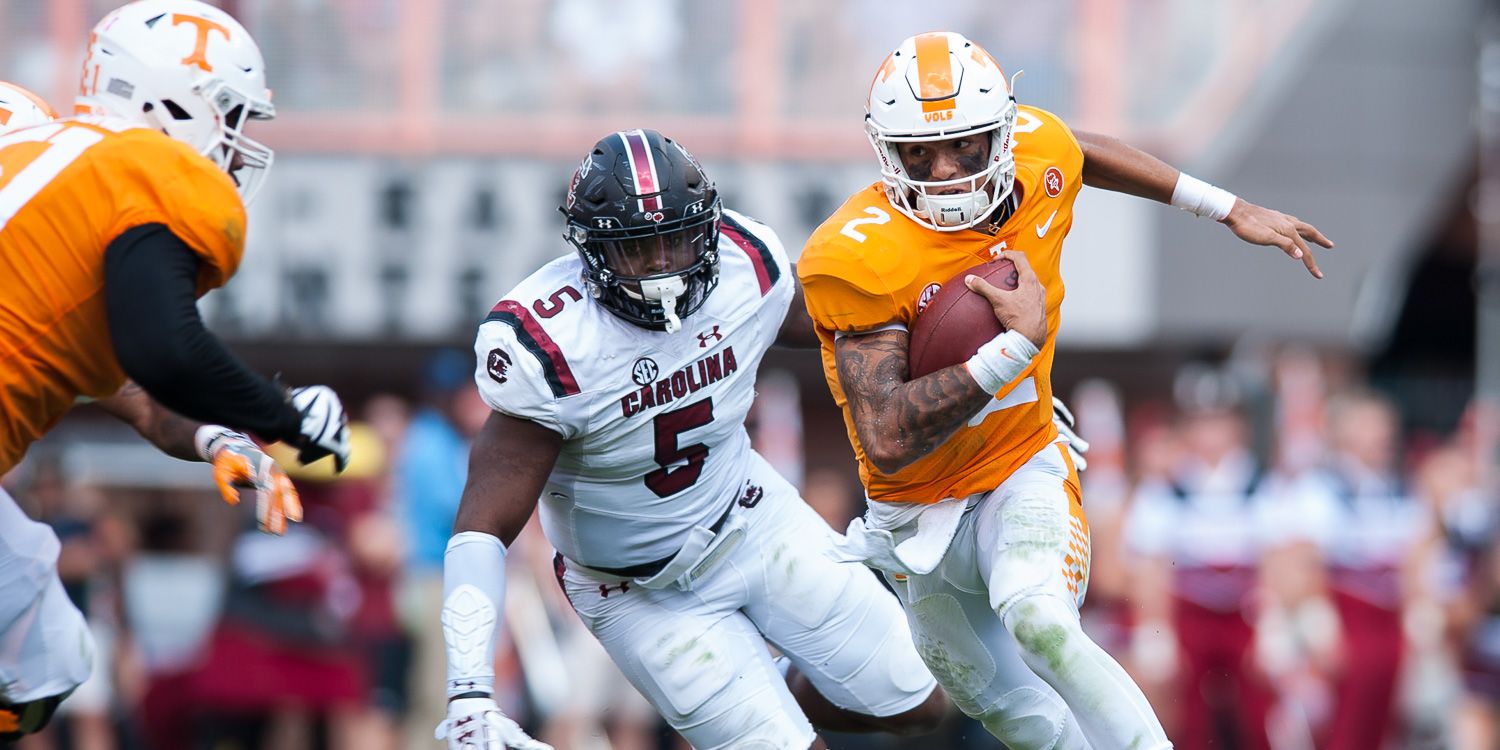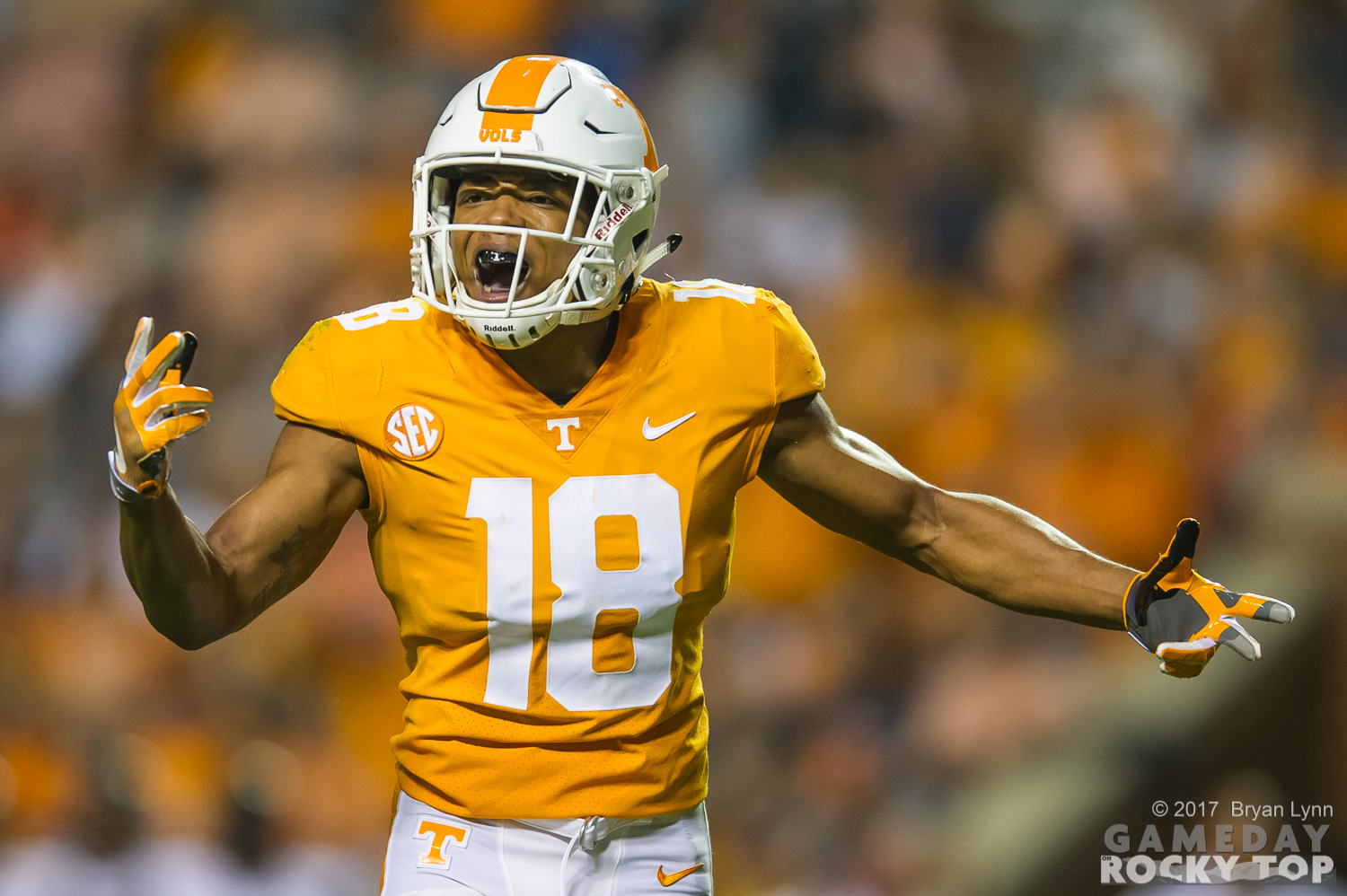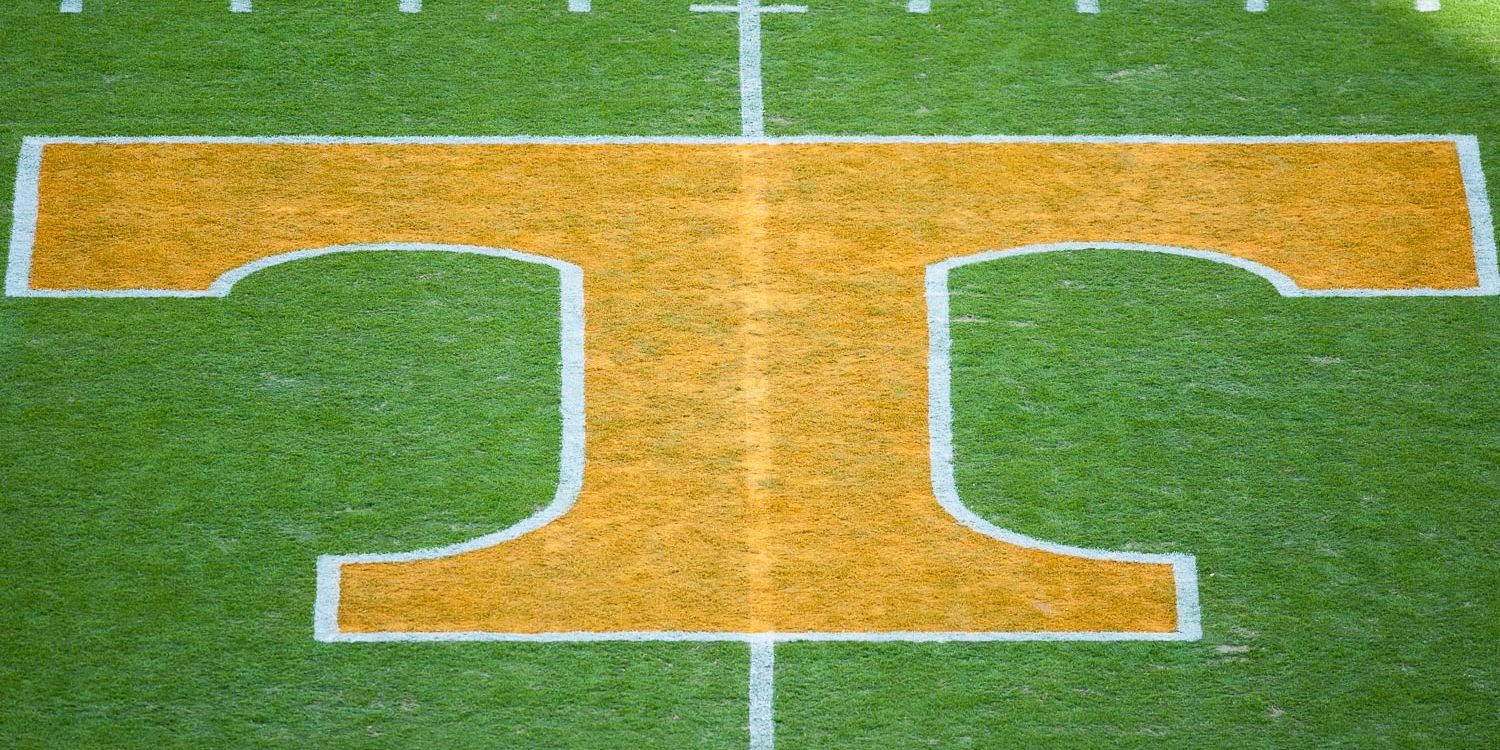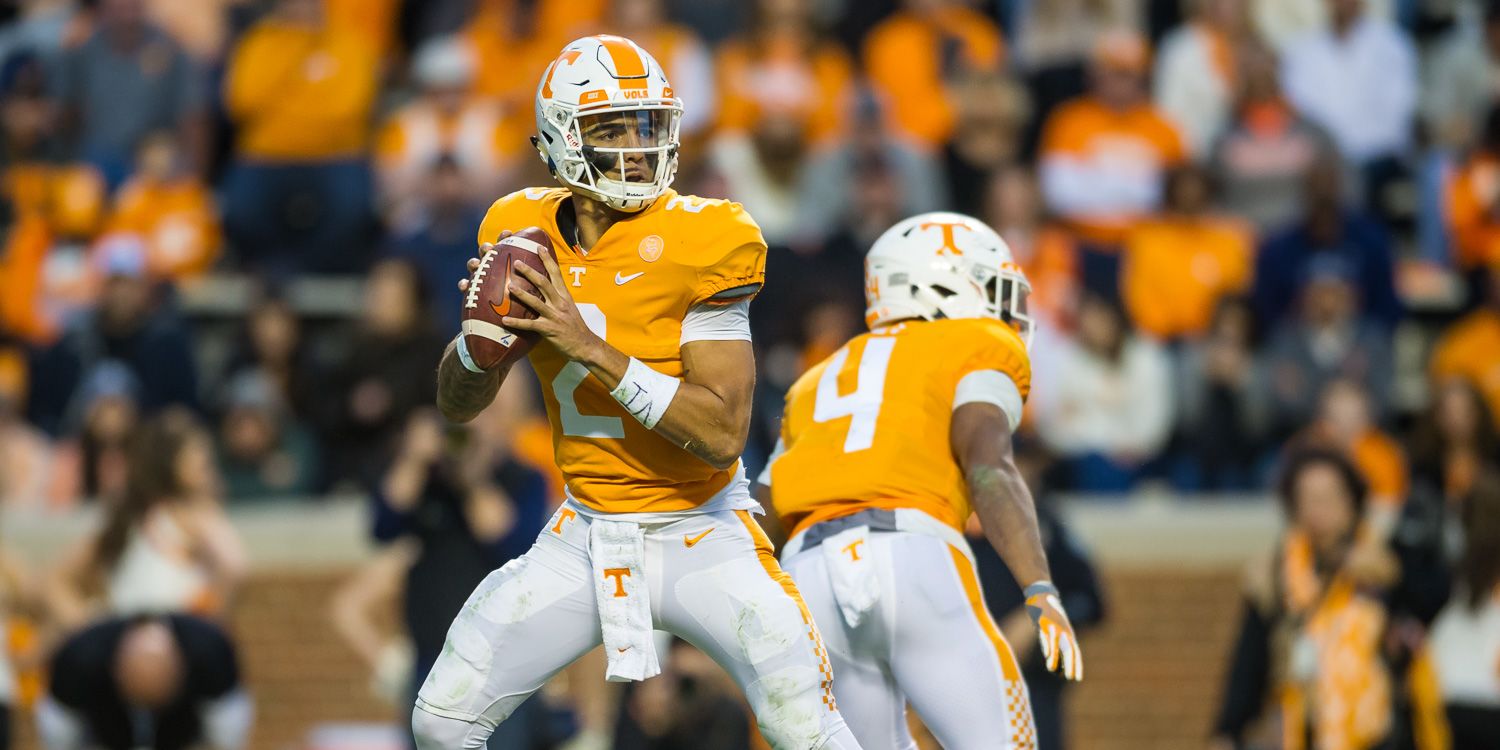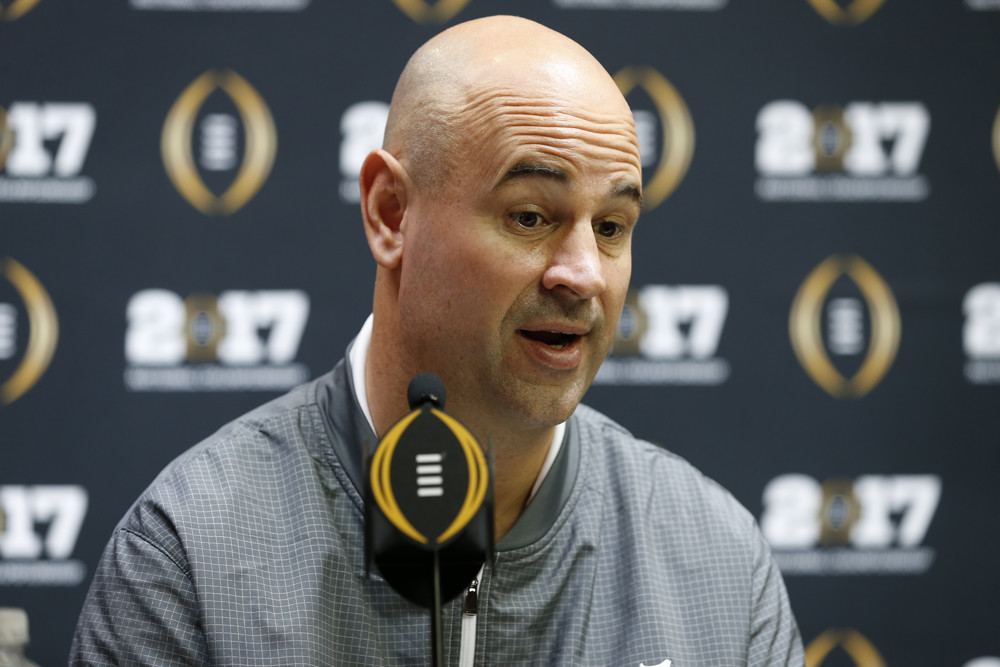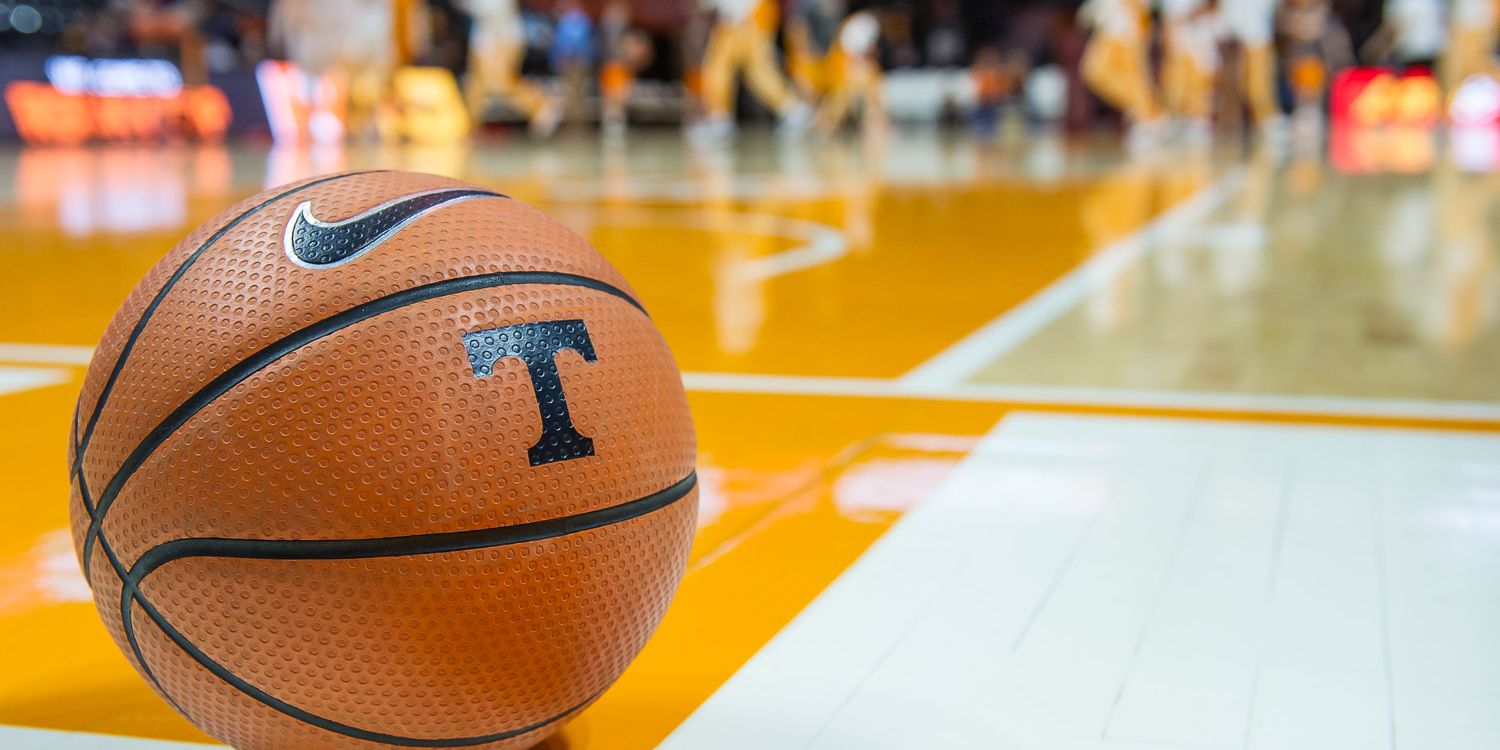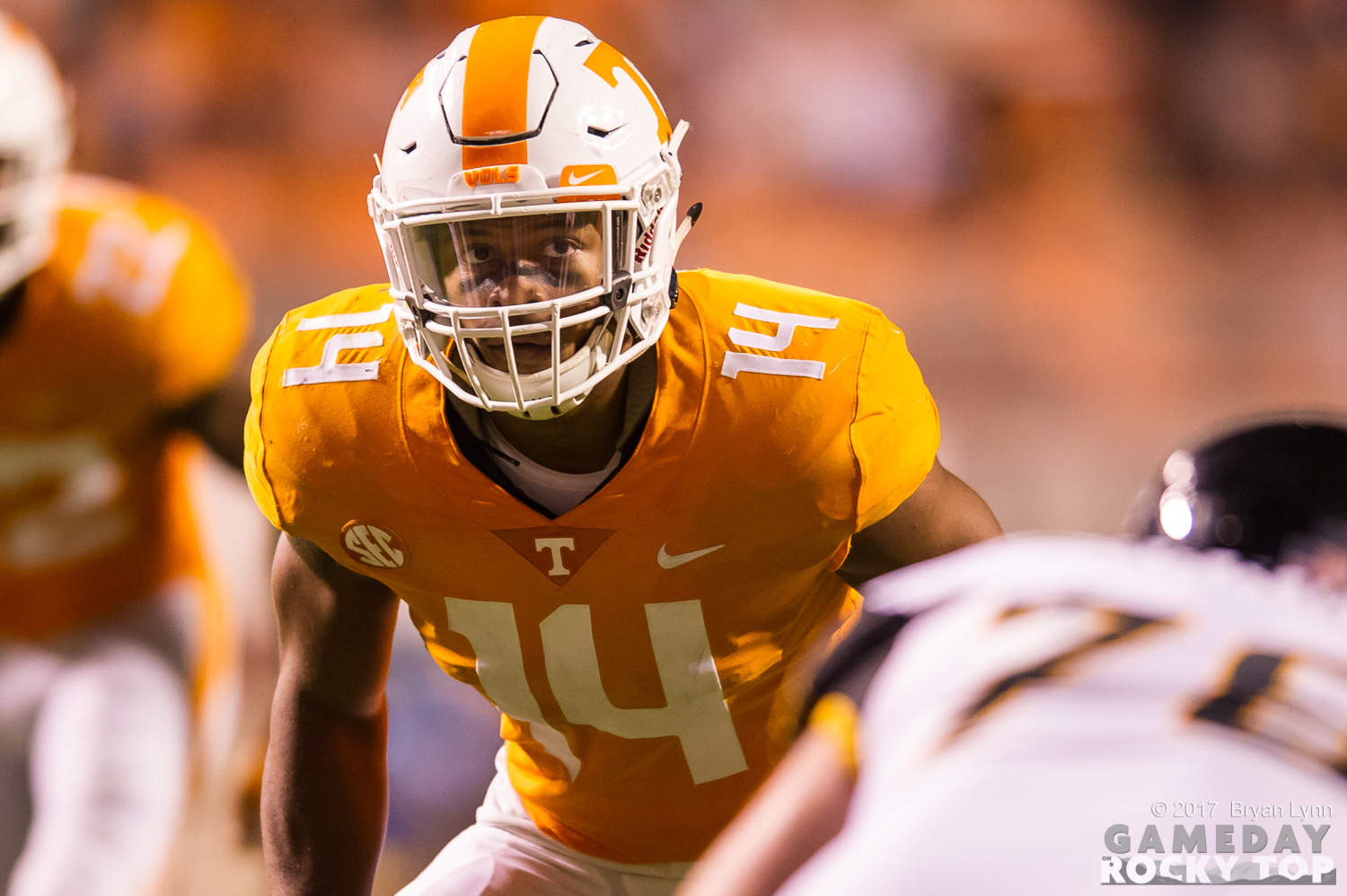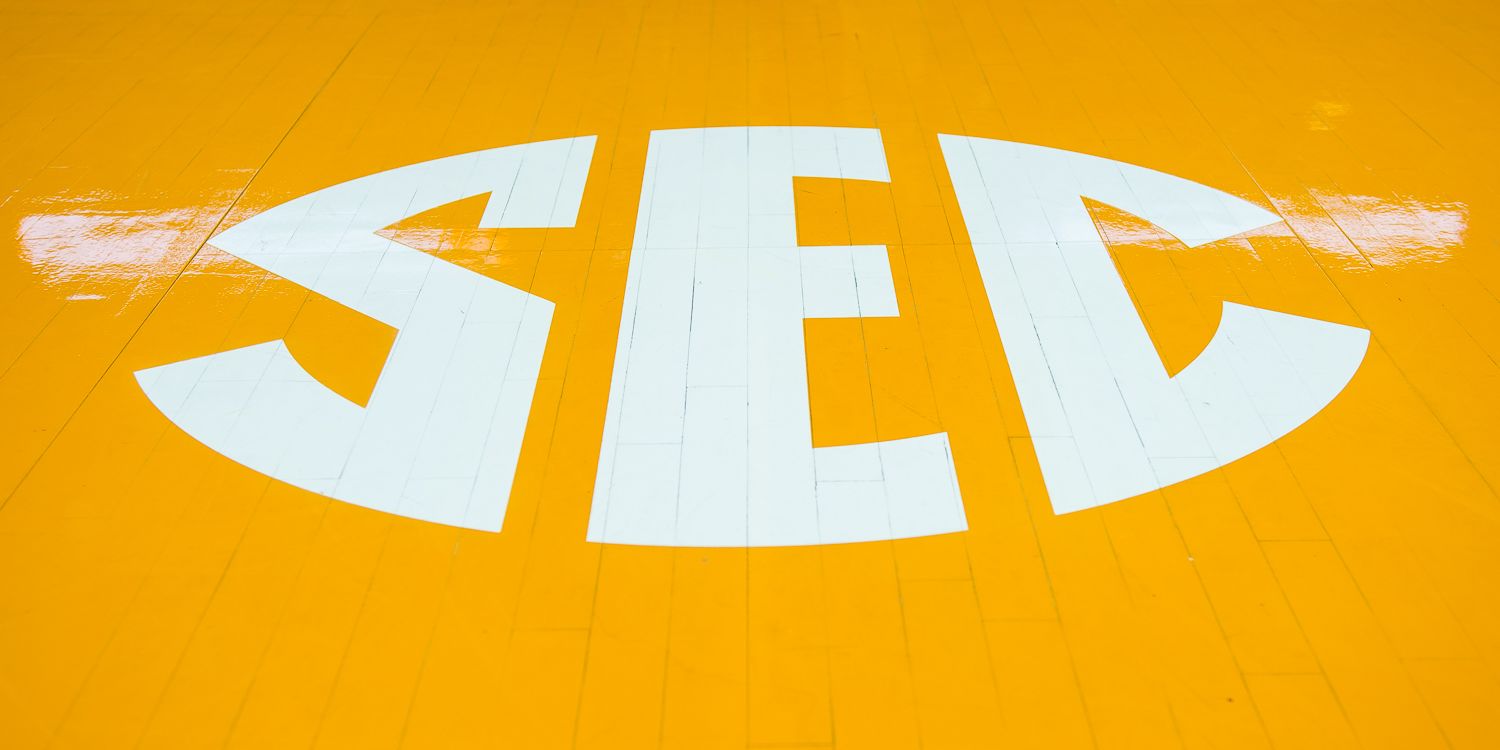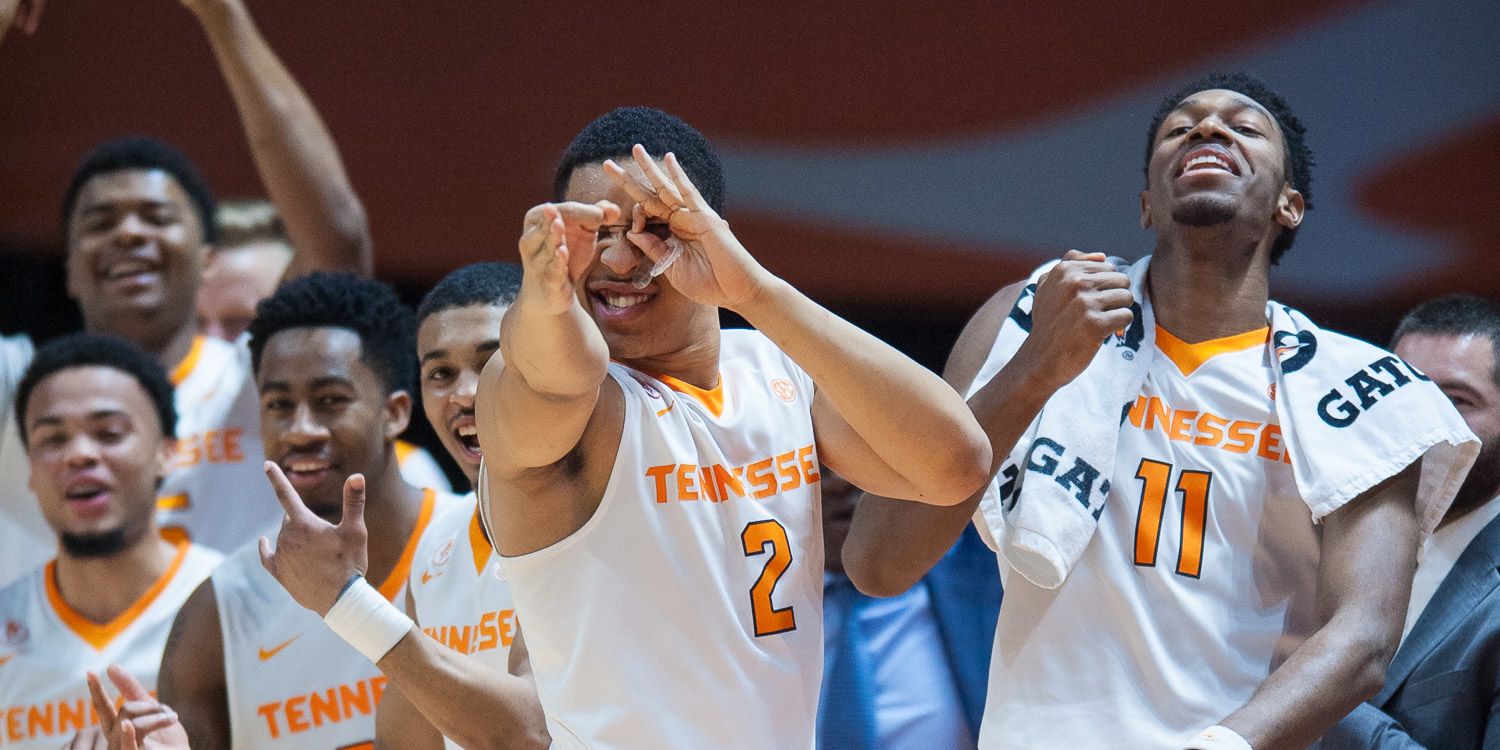With temperatures expected to be beautiful under sunny skies and a lot of top-notch recruits heading to Knoxville to enjoy the festivities, the biggest focus needs to be on Shields-Watkins Field.
The top recruits aren’t going to head to Rocky Top without marked improvement on the field.
The Vols have released Saturday’s starters.
So, what are some things you need to see if you’re heading to the Orange & White Game on Saturday? Let’s take a look.
Jarrett Guarantano’s Improvement
Guarantano has been locked in a “battle” all spring with sophomore Will McBride, but his real competition arrives this fall when Stanford transfer Keller Chryst gets to town. With so little practice opened to the public or the media and so little coming from the mouths of coaches, we’re left searching for clues about Guarantano’s development.
This was once, after all, the nation’s top-ranked dual-threat quarterback, known for being able to run away from pressure and have the arm strength to throw receivers open downfield.
The receiving corps should be much improved this spring, even without Jauan Jennings healthy yet. Also, it’s going to be intriguing to see Guarantano in a passing offense that is determined to throw some downfield and actually use (gasp!) vertical passing patterns.
Has Guarantano’s internal clock improved, or will he still take too many sacks? Has he developed confidence enough in his arm to make the vital throws downfield? Will he get any help from his friends on the perimeter? What will he look like since he’s put on 15-20 pounds of muscle? Has it helped his already-strong arm talent? Will he be able to tuck-and-run under pressure?
There’s so much we need to see. I believe Tennessee’s ceiling is tied directly to Guarantano’s development in offensive coordinator Tyson Helton’s scheme. This is our first look at him operating it.
About those friends…
If Guarantano (or Chryst) is going to have success this season, Tennessee’s receiving corps needs to be much better than it ever was under the Butch Jones/Zach Azzanni/Kevin Beard days. Though Josh Malone had a nice junior season in 2016, the Vols rarely had any splash seasons out of its targets. (That’s hard to do when you’re constantly running toward the sideline.)
With Helton calling plays and renowned receivers coach David Johnson coaching up the pass-catchers, the Vols could show a dramatic improvement at the position. If Jennings keeps his head on straight, he will be an excellent No. 1 option in his junior year. That pushes Marquez Callaway and Brandon Johnson — a junior duo who have shown flashes — to a support role, where they could thrive. That isn’t a bad trio around which to start your offensive rebuild. Jennings won’t be on the field tomorrow, but it’ll be good to see if Callaway and Johnson can look the part of consistent SEC playmakers.
Beyond those guys, there’s more talent still. LaTrell Williams’ speed is an X-factor if he can stay healthy in the slot, and Tyler Byrd is back on that side of the ball after a failed experiment in the secondary. Jordan Murphy was once a 4-star recruit from Mississippi who came in and redshirted last year as an undersized prospect. He’s reportedly looked good at times this spring. Jacquez Jones drew some praise at the beginning of camp, and Joshua Palmer was a kid who got a lot of key reps as a true freshman a year ago.
There are playmakers in that bunch. The Vols just have to find them. And that’s taking into consideration the possibility that freshman Alontae Taylor will stay at cornerback, where he’s been a revelation so far. If he doesn’t, he’ll play some snaps on offense.
Taylor time
It’s hard to find potential stars on the roster Jones left coach Jeremy Pruitt, but the freshman who wound up staying home and choosing the Vols rather than go to Georgia or Alabama may be one. He wants to play offense, but Pruitt moved him to cornerback where UT needs a ton of help, and he may emerge as a starter on that side of the ball.
If he does, will the former Coffee County High School star embrace the role at cornerback? Or will he want to go back to catching passes, instead?
It’s possible he could get snaps on both sides of the ball in the spring game, and he looks like a budding star. You should watch him closely, because he’s going to help the ’18 Vols in some capacity. His final destination is yet to be determined, and he may wind up playing everywhere.
Alontae Taylor is that good.
Who can we rely on up front?
Simply put: The Vols need Trey Smith, K’rojhn Calbert and Chance Hall to be healthy come fall to have any chance of piecing together an offensive line capable of winning important games (or, heck, any games) in the SEC.
Smith is an All-American waiting to happen who isn’t playing this spring as he deals with an undisclosed medical issue. His career is in jeopardy, and though there’s some hope around him playing, it’s not a guarantee. That would be a crucial blow to UT and a young man who has such an incredible future in front of him. Calbert is a physical specimen who looks the part as a redshirt freshman but needs his knees to hold up to be a factor. He will be eventually, but will it be this year? And Hall’s knee issues have kept him off the field for two seasons after such a promising start to his career. That’s cautious optimism at best, but he’s in pads this spring. Will it stick?
So, with those guys out, why even bother with the line? Well, there are players we need to take giant leaps forward. Drew Richmond was once a 5-star National Signing Day flip who looked like a future anchor of the line. Entering his junior season, it’s important he turns it up a notch after an awful year in 2017. With Will Friend coaching him now, the long-time veteran coach should squeeze the most out of him.
Others I want to see are redshirt freshman center Riley Locklear and true freshman mid-term enrollee Jerome Carvin. Those are two kids who may wind up relied on this year, and they both have the ability to be excellent linemen. How far can they progress? Marcus Tatum has added weight on the outside, and Ryan Johnson will get an opportunity to show what he can do as well.
This offensive line isn’t in great shape at all, but if they can develop and UT can get the three injured players back along with JUCO transfer Jahmir Johnson, the Vols could piece together an OK front. That’s a big “if”, but we need to see who can be trusted tomorrow.
Ty-no-mite
For all the talk Pruitt has dished out about loving and wanting bigger backs, this spring has been about Ty Chandler proving he is still the top playmaker on that offense, regardless of size.
Chandler played at 5’11”, 195 pounds a season ago and had 253 yards and a pair of touchdowns in a reserve role to John Kelly as a true freshman. Though the Vols will have several bigger runners getting carries like Michigan State transfer Madre London and the sophomore duo of Trey Coleman and Tim Jordan, this is Chandler’s offense.
He is more than 200 pounds now and can carry the load between the tackles. He’s also got another gear when he can get to the second level. Just how good of a year he can have depends on the development of the offensive line, but Chandler has a ton of talent. He’s the former No. 5 running back in the 2016 class, so he can play.
He’ll get his opportunity this year, and it’ll be exciting to see if he can break some plays tomorrow.
Not Shy about this need
One of the most important positions on Pruitt’s defense is the cog in the middle. There have been reports this spring of it being difficult for UT runners to find lanes. Is that because the offensive line is awful, or because the defensive line is playing better than expected?
This is Shy Tuttle’s final year in Knoxville. At times, he was UT’s most effective defensive lineman, but injuries derailed a once-impressive career. Last year, he was just OK in a Bob Shoop unit that was dreadful against the run. He’s found a second wind this spring, and though he isn’t the bulkiest lineman, he’s going to be the cog in the center of that defensive line.
The Vols need for him to hold his own, clog up the middle and push running plays to the outside. You must have a quality defensive line to compete in the SEC, and the Vols never had that under Jones. If they’re going to surprise on that side of the ball in ’18, Tuttle needs to be the glue guy in the center of the offense.
He may just be the most important puzzle piece over there.
A glimmer of hope on the second level
All the question marks surrounding the Vols are worrisome, but there appears to be excitement at linebacker, where they have a wealth of potential playmakers. Even with Darrin Kirkland Jr. and Daniel Bituli — two big ‘backers tailor-made for the interior of a 3-4 scheme — out for much of this spring, they’ve found capable players at the position.
Quart’e Sapp has always been fast, and he’s noticeably added weight and is making a ton of plays this spring. He appears to be a factor on the interior along with sophomore Will Ignont, a Buckhorn High School product from New Market, Alabama, near the Tennessee state line, who looks to be ideal for that position as well. Between those four battlers, the Vols are going to be stout on the interior of the linebacking corps, and all will play. Can Sapp slide over and play on the outside? He’s big enough to.
The Vols have a very good problem at that spot, and I’m excited to watch Sapp and Ignont in the middle tomorrow. They’ve drawn a lot of praise. Bituli is back and playing tomorrow, which is exciting, because he’s a big-time playmaker who looks like a great fit for this defense.
On the outside, Austin Smith is leading the battle against JUCO transfer Jordan Allen and others right now, and former defensive end Darrell Taylor is the pass-rushing Jack linebacker who has a lock on a starting gig. Deandre Johnson has enjoyed a nice spring and is starting at the other outside spot over Smith and others. That’s a big development.
Coveted recruit J.J. Peterson isn’t even on campus yet, so he will challenge Smith and Johnson. There are a lot of excellent options on the second level for the Vols, at a position that looks to be one of strength. We’ll hopefully get a glimpse of that tomorrow.
Who’s with Warrior?
Finally, Nigel Warrior looks like the bell cow of this defense on the back level. But who’s going to roll with him in the secondary?
We’ve already talked about Taylor’s emergence as Pruitt looks to find capable corners. Marquill Osborne hasn’t taken full advantage of his opportunity this spring like many hoped, but others have. Osborne did, however, come on at the end of spring and is listed as a spring game starter. Shawn Shamburger looks like the probable Star right now — a vital position in Pruitt’s defense. The Vols should have had senior Rashaan Gaulden at that spot, but he left for the NFL when he should have stayed. So, that’s a spot up for grabs.
Baylen Buchanan has emerged, and the junior from Lawrenceville, Georgia, recognizes his time to shine. He’s the son of former NFL All-Pro cornerback Big Play Ray Buchanan, and though he struggled a year ago, he did see the field as a true freshman, so this isn’t out of the blue. He looks to be a starter at corner.
Theo Jackson and Cheyenne Labruzza are two other players who’ll be able to help, but where and in what capacity? Shamburger and Jackson look like the two most capable players this spring, but do they have big-play ability? Micah Abernathy has been great at times during his career at UT but is coming off an awful season in Jones’ final campaign. If he returns to form and the Vols get Todd Kelly Jr. back healthy this fall, they’ll have some potential players in the secondary.
But cornerback is a major concern, and so is depth and youth. The Vols need to find players back there quickly. Trevon Flowers, Kenny George Jr., and Brandon Davis arrive this summer to hopefully help.
